
Question Number 3714 by Rasheed Soomro last updated on 19/Dec/15
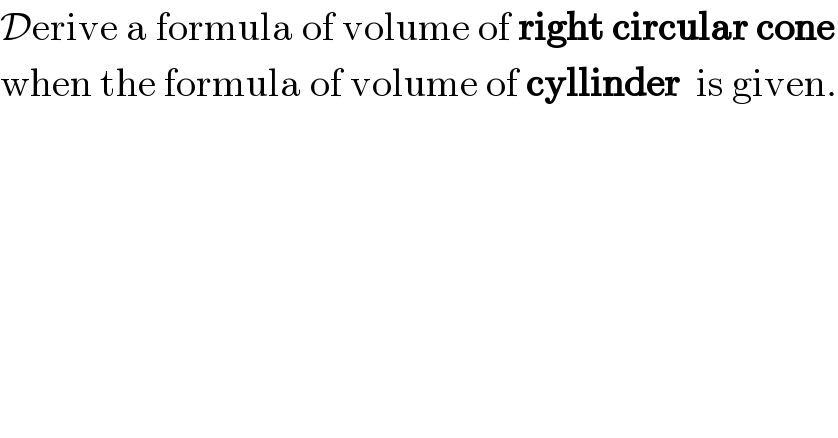
$$\mathcal{D}\mathrm{erive}\:\mathrm{a}\:\mathrm{formula}\:\mathrm{of}\:\mathrm{volume}\:\mathrm{of}\:\boldsymbol{\mathrm{right}}\:\boldsymbol{\mathrm{circular}}\:\boldsymbol{\mathrm{cone}} \\ $$$$\mathrm{when}\:\mathrm{the}\:\mathrm{formula}\:\mathrm{of}\:\mathrm{volume}\:\mathrm{of}\:\boldsymbol{\mathrm{cyllinder}}\:\:\mathrm{is}\:\mathrm{given}. \\ $$
Answered by Filup last updated on 19/Dec/15
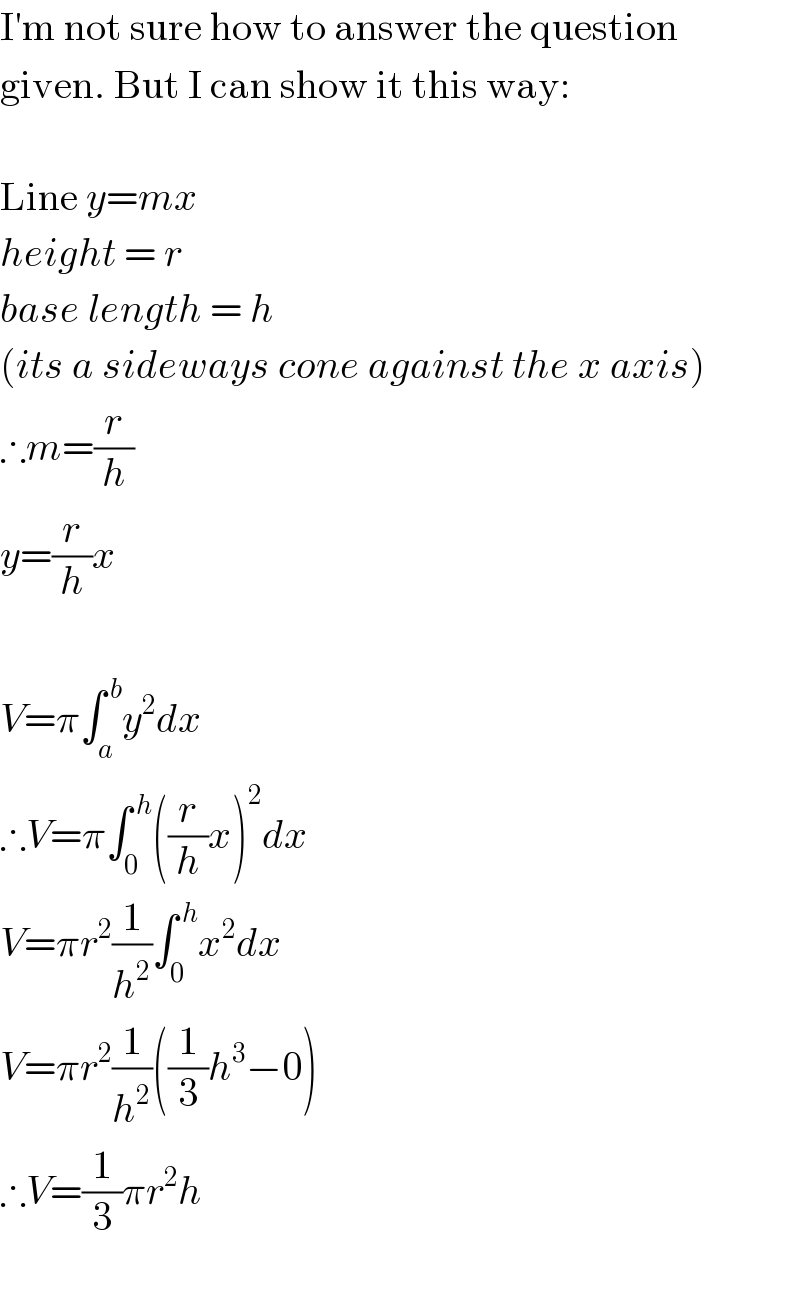
$$\mathrm{I}'\mathrm{m}\:\mathrm{not}\:\mathrm{sure}\:\mathrm{how}\:\mathrm{to}\:\mathrm{answer}\:\mathrm{the}\:\mathrm{question} \\ $$$$\mathrm{given}.\:\mathrm{But}\:\mathrm{I}\:\mathrm{can}\:\mathrm{show}\:\mathrm{it}\:\mathrm{this}\:\mathrm{way}: \\ $$$$ \\ $$$$\mathrm{Line}\:{y}={mx} \\ $$$${height}\:=\:{r} \\ $$$${base}\:{length}\:=\:{h} \\ $$$$\left({its}\:{a}\:{sideways}\:{cone}\:{against}\:{the}\:{x}\:{axis}\right) \\ $$$$\therefore{m}=\frac{{r}}{{h}} \\ $$$${y}=\frac{{r}}{{h}}{x} \\ $$$$ \\ $$$${V}=\pi\int_{{a}} ^{\:{b}} {y}^{\mathrm{2}} {dx} \\ $$$$\therefore{V}=\pi\int_{\mathrm{0}} ^{\:{h}} \left(\frac{{r}}{{h}}{x}\right)^{\mathrm{2}} {dx} \\ $$$${V}=\pi{r}^{\mathrm{2}} \frac{\mathrm{1}}{{h}^{\mathrm{2}} }\int_{\mathrm{0}} ^{\:{h}} {x}^{\mathrm{2}} {dx} \\ $$$${V}=\pi{r}^{\mathrm{2}} \frac{\mathrm{1}}{{h}^{\mathrm{2}} }\left(\frac{\mathrm{1}}{\mathrm{3}}{h}^{\mathrm{3}} −\mathrm{0}\right) \\ $$$$\therefore{V}=\frac{\mathrm{1}}{\mathrm{3}}\pi{r}^{\mathrm{2}} {h} \\ $$$$ \\ $$
Commented by RasheedSindhi last updated on 19/Dec/15

$${Integral}\:{is}\:{used}\:{for}\:{area}. \\ $$$${How}\:{is}\:{it}\:{used}\:{for}\:{volume}? \\ $$$${Which}\:{line}\:{is}\:{y}={mx}\:? \\ $$
Commented by Filup last updated on 19/Dec/15
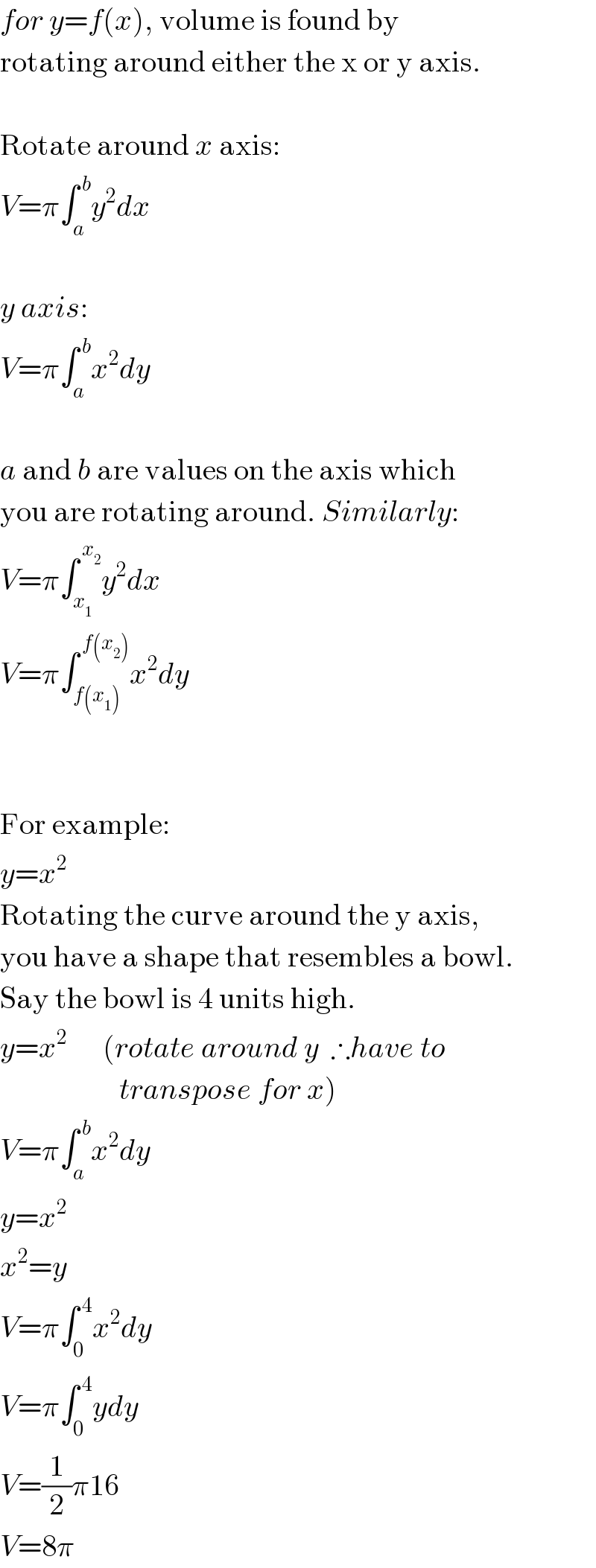
$${for}\:{y}={f}\left({x}\right),\:\mathrm{volume}\:\mathrm{is}\:\mathrm{found}\:\mathrm{by} \\ $$$$\mathrm{rotating}\:\mathrm{around}\:\mathrm{either}\:\mathrm{the}\:\mathrm{x}\:\mathrm{or}\:\mathrm{y}\:\mathrm{axis}. \\ $$$$ \\ $$$$\mathrm{Rotate}\:\mathrm{around}\:{x}\:\mathrm{axis}: \\ $$$${V}=\pi\int_{{a}} ^{\:{b}} {y}^{\mathrm{2}} {dx} \\ $$$$ \\ $$$${y}\:{axis}: \\ $$$${V}=\pi\int_{{a}} ^{\:{b}} {x}^{\mathrm{2}} {dy} \\ $$$$ \\ $$$${a}\:\mathrm{and}\:{b}\:\mathrm{are}\:\mathrm{values}\:\mathrm{on}\:\mathrm{the}\:\mathrm{axis}\:\mathrm{which} \\ $$$$\mathrm{you}\:\mathrm{are}\:\mathrm{rotating}\:\mathrm{around}.\:{Similarly}: \\ $$$${V}=\pi\int_{{x}_{\mathrm{1}} } ^{\:{x}_{\mathrm{2}} } {y}^{\mathrm{2}} {dx} \\ $$$${V}=\pi\int_{{f}\left({x}_{\mathrm{1}} \right)} ^{\:{f}\left({x}_{\mathrm{2}} \right)} {x}^{\mathrm{2}} {dy} \\ $$$$ \\ $$$$ \\ $$$$\mathrm{For}\:\mathrm{example}: \\ $$$${y}={x}^{\mathrm{2}} \\ $$$$\mathrm{Rotating}\:\mathrm{the}\:\mathrm{curve}\:\mathrm{around}\:\mathrm{the}\:\mathrm{y}\:\mathrm{axis}, \\ $$$$\mathrm{you}\:\mathrm{have}\:\mathrm{a}\:\mathrm{shape}\:\mathrm{that}\:\mathrm{resembles}\:\mathrm{a}\:\mathrm{bowl}. \\ $$$$\mathrm{Say}\:\mathrm{the}\:\mathrm{bowl}\:\mathrm{is}\:\mathrm{4}\:\mathrm{units}\:\mathrm{high}. \\ $$$${y}={x}^{\mathrm{2}} \:\:\:\:\:\:\left({rotate}\:{around}\:{y}\:\:\therefore{have}\:{to}\right. \\ $$$$\left.\:\:\:\:\:\:\:\:\:\:\:\:\:\:\:\:\:\:\:\:{transpose}\:{for}\:{x}\right) \\ $$$${V}=\pi\int_{{a}} ^{\:{b}} {x}^{\mathrm{2}} {dy} \\ $$$${y}={x}^{\mathrm{2}} \\ $$$${x}^{\mathrm{2}} ={y} \\ $$$${V}=\pi\int_{\mathrm{0}} ^{\:\mathrm{4}} {x}^{\mathrm{2}} {dy} \\ $$$${V}=\pi\int_{\mathrm{0}} ^{\:\mathrm{4}} {ydy} \\ $$$${V}=\frac{\mathrm{1}}{\mathrm{2}}\pi\mathrm{16} \\ $$$${V}=\mathrm{8}\pi \\ $$
Commented by Filup last updated on 19/Dec/15
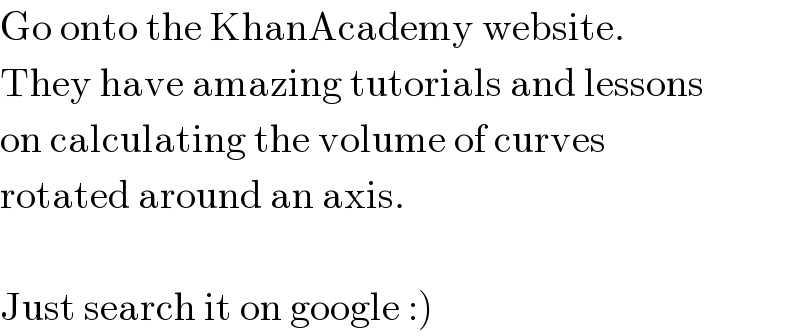
$$\mathrm{Go}\:\mathrm{onto}\:\mathrm{the}\:\mathrm{KhanAcademy}\:\mathrm{website}. \\ $$$$\mathrm{They}\:\mathrm{have}\:\mathrm{amazing}\:\mathrm{tutorials}\:\mathrm{and}\:\mathrm{lessons} \\ $$$$\mathrm{on}\:\mathrm{calculating}\:\mathrm{the}\:\mathrm{volume}\:\mathrm{of}\:\mathrm{curves} \\ $$$$\mathrm{rotated}\:\mathrm{around}\:\mathrm{an}\:\mathrm{axis}. \\ $$$$ \\ $$$$\left.\mathrm{Just}\:\mathrm{search}\:\mathrm{it}\:\mathrm{on}\:\mathrm{google}\::\right) \\ $$
Commented by RasheedSindhi last updated on 19/Dec/15

$$\mathcal{T}{h}^{\alpha} {nk}\mathcal{S}! \\ $$
Commented by Rasheed Soomro last updated on 22/Dec/15
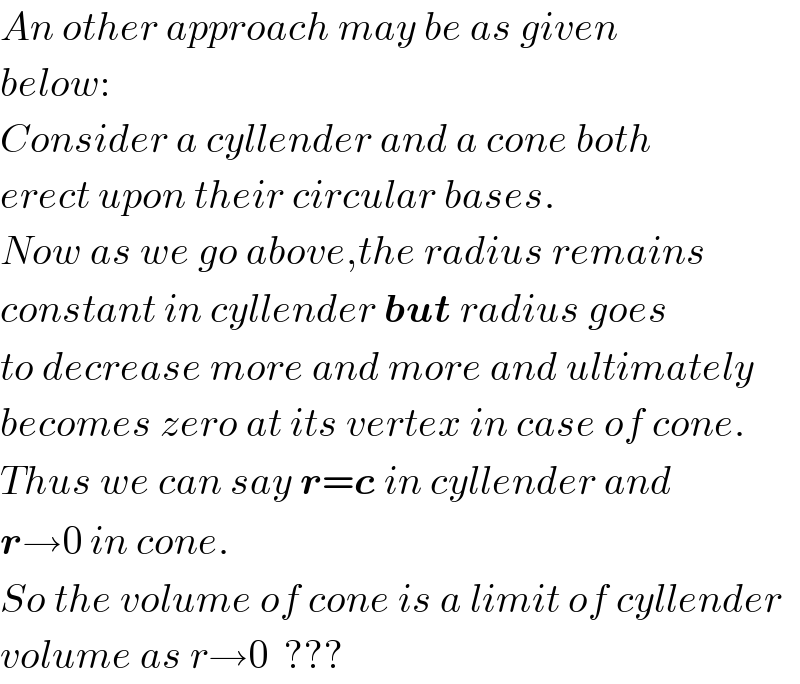
$${An}\:{other}\:{approach}\:{may}\:{be}\:{as}\:{given} \\ $$$${below}: \\ $$$${Consider}\:{a}\:{cyllender}\:{and}\:{a}\:{cone}\:{both} \\ $$$${erect}\:{upon}\:{their}\:{circular}\:{bases}. \\ $$$${Now}\:{as}\:{we}\:{go}\:{above},{the}\:{radius}\:{remains} \\ $$$${constant}\:{in}\:{cyllender}\:\boldsymbol{{but}}\:{radius}\:{goes} \\ $$$${to}\:{decrease}\:{more}\:{and}\:{more}\:{and}\:{ultimately} \\ $$$${becomes}\:{zero}\:{at}\:{its}\:{vertex}\:{in}\:{case}\:{of}\:{cone}. \\ $$$${Thus}\:{we}\:{can}\:{say}\:\boldsymbol{{r}}=\boldsymbol{{c}}\:{in}\:{cyllender}\:{and} \\ $$$$\boldsymbol{{r}}\rightarrow\mathrm{0}\:{in}\:{cone}. \\ $$$${So}\:{the}\:{volume}\:{of}\:{cone}\:{is}\:{a}\:{limit}\:{of}\:{cyllender} \\ $$$${volume}\:{as}\:{r}\rightarrow\mathrm{0}\:\:??? \\ $$
